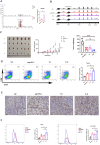Blautia coccoides and its metabolic products enhance the efficacy of bladder cancer immunotherapy by promoting CD8+ T cell infiltration
- PMID: 39449013
- PMCID: PMC11515615
- DOI: 10.1186/s12967-024-05762-y
Blautia coccoides and its metabolic products enhance the efficacy of bladder cancer immunotherapy by promoting CD8+ T cell infiltration
Abstract
Background: Immune checkpoint inhibitors (ICIs) have emerged as a novel and effective treatment strategy, yet their effectiveness is limited to a subset of patients. The gut microbiota, recognized as a promising anticancer adjuvant, is being increasingly suggested to augment the efficacy of ICIs. Despite this, the causal link between the gut microbiota and the success of immunotherapy is not well understood. This gap in knowledge has driven us to identify beneficial microbiota and explore the underlying molecular mechanisms.
Methods: Through 16S rDNA sequencing, we identified distinct gut microbiota in patients undergoing treatment with ICIs. Following this, we assessed the impact of probiotics on anti-PD-1 therapy in bladder cancer using mouse models, employing a multi-omics strategy. Subsequently, we uncovered the mechanisms through which Blautia-produced metabolites enhance antitumor immunity, utilizing untargeted metabolomics and a range of molecular biology techniques.
Results: In our research, the LEfSe analysis revealed a significant enrichment of the Blautia genus in the gut microbiota of patients who responded to immunotherapy. We discovered that the external addition of Blautia coccoides hampers tumor growth in a bladder cancer mouse model by enhancing the infiltration of CD8+ T cells within the tumor microenvironment (TME). Further investigations through untargeted metabolomics and molecular biology experiments showed that oral administration of Blautia coccoides elevated trigonelline levels. This, in turn, suppresses the β-catenin expression both in vitro and in vivo, thereby augmenting the cancer-killing activity of CD8+ T cells.
Conclusions: This research provided valuable insights into enhancing the efficacy of PD-1 inhibitors in clinical settings. It was suggested that applying Blautia coccoides and its metabolic product, trigonelline, could serve as a synergistic treatment method with PD-1 inhibitors in clinical applications.
Keywords: Blautia coccoides; Anti-PD-1 immunotherapy; Gut microbiota; Trigonelline.
© 2024. The Author(s).
Conflict of interest statement
None declared.
Figures







Similar articles
-
Gut microbiota Parabacteroides distasonis enchances the efficacy of immunotherapy for bladder cancer by activating anti-tumor immune responses.BMC Microbiol. 2024 Jul 3;24(1):237. doi: 10.1186/s12866-024-03372-8. BMC Microbiol. 2024. PMID: 38961326 Free PMC article.
-
MS-20 enhances the gut microbiota-associated antitumor effects of anti-PD1 antibody.Gut Microbes. 2024 Jan-Dec;16(1):2380061. doi: 10.1080/19490976.2024.2380061. Epub 2024 Jul 30. Gut Microbes. 2024. PMID: 39078050 Free PMC article.
-
Single-cell transcriptomic analysis reveals gut microbiota-immunotherapy synergy through modulating tumor microenvironment.Signal Transduct Target Ther. 2025 May 2;10(1):140. doi: 10.1038/s41392-025-02226-7. Signal Transduct Target Ther. 2025. PMID: 40312419 Free PMC article.
-
Modulation of Gut Microbiota to Enhance Effect of Checkpoint Inhibitor Immunotherapy.Front Immunol. 2021 Jun 29;12:669150. doi: 10.3389/fimmu.2021.669150. eCollection 2021. Front Immunol. 2021. PMID: 34267748 Free PMC article. Review.
-
The role of the gut microbiota in tumor, immunity, and immunotherapy.Front Immunol. 2024 Jun 5;15:1410928. doi: 10.3389/fimmu.2024.1410928. eCollection 2024. Front Immunol. 2024. PMID: 38903520 Free PMC article. Review.
Cited by
-
Causal relationships between gut microbiota and urothelial carcinoma mediated by inflammatory cytokines and blood cell traits identified through Mendelian randomization analysis.Discov Oncol. 2025 Jul 30;16(1):1440. doi: 10.1007/s12672-025-03219-2. Discov Oncol. 2025. PMID: 40736872 Free PMC article.
-
Metagenomic Microbial Signatures for Noninvasive Detection of Pancreatic Cancer.Biomedicines. 2025 Apr 21;13(4):1000. doi: 10.3390/biomedicines13041000. Biomedicines. 2025. PMID: 40299688 Free PMC article.
-
Microbiota and urinary tumor immunity: Mechanisms, therapeutic implications, and future perspectives.Chin J Cancer Res. 2024 Dec 30;36(6):596-615. doi: 10.21147/j.issn.1000-9604.2024.06.03. Chin J Cancer Res. 2024. PMID: 39802902 Free PMC article. No abstract available.
References
-
- Sung H, et al. Global Cancer Statistics 2020: GLOBOCAN estimates of incidence and mortality worldwide for 36 cancers in 185 countries. CA Cancer J Clin. 2021;71(3):209–49. - PubMed
-
- Knowles MA, Hurst CD. Molecular biology of bladder cancer: new insights into pathogenesis and clinical diversity. Nat Rev Cancer. 2015;15(1):25–41. - PubMed
MeSH terms
Substances
Grants and funding
LinkOut - more resources
Full Text Sources
Medical
Research Materials
Miscellaneous

